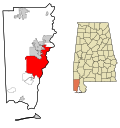Carlen House | |
 The Carlen House in 2008. | |
| Location | 54 South Carlen Street Mobile, Alabama |
|---|---|
| Coordinates | 30°41′3″N88°5′10″W / 30.68417°N 88.08611°W |
| Area | 0.2 acres (0.081 ha) |
| Built | 1843 |
| Architectural style | Gulf Coast cottage |
| NRHP reference No. | 81000131 [1] |
| Added to NRHP | June 12, 1981 |
The Carlen House, also known as the Carlen House Museum, is a historic house museum in Mobile, Alabama, United States. The house was built in the Gulf Coast cottage style in 1843. [1] It was the residence of Michael and Mary Carlen, Irish immigrants, and their twelve children. Operated as a farm during the 19th century, the Mobile County School Board acquired 38 acres (15 ha) of the property from the Carlen family in 1923 as the site for a new public city school. As a result, the house is now on the northern edge of the Murphy High School campus. [2] It was placed on the National Register of Historic Places on June 12, 1981. [1]
The house is currently not open to the public, however is used by the Murphy High School students on occasion. [3]



